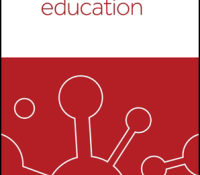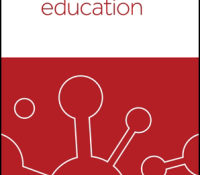tandfonline.com har udgivet en rapport under søgningen „Teacher Education Mathematics‟: ABSTRACT ABSTRACT Across the world, teacher quality has come to be recognised as one of the most important variables affecting student outcomes; consequently, the regulation of entry into the profession is the subject of iterative review. The traditional ‘one-off’ interview, involving an interviewee and two or more interviewers, is a common, but not unproblematic, selection mechanism in the field. In particular, the modest positive correlation between performance at interviews and in clinical settings raises questions about using interviews as a selection mechanism for Initial Teacher Education (ITE) programmes. In this paper, we draw on validity theory and some key commentaries and studies in the research literature to offer a perspective on the extent to which the traditional interview provides data… Continue Reading →
Like this:
Like Loading...
tandfonline.com har udgivet en rapport under søgningen „Teacher Education Mathematics‟: ABSTRACT ABSTRACT The study focuses on the assessment of young refugee students, and the role of language and parents therein. Low achievement at tests can stem from lack of knowledge of the content being tested. However, it can also be due to low proficiency in the language of testing. Additionally, poor communication between refugee parents and schools caused by language or cultural differences may lead to underestimation of children’s potential. We investigated, first, to what extent the language factor affects the performance of young Syrian refugee students in the Netherlands in mathematics and, second, the validity of parents’ judgements of their children’s mathematics ability. A linear mixed-effects model with random intercepts per participant was used to analyze the data. Results… Continue Reading →
Like this:
Like Loading...
eric.ed.gov har udgivet: The Early Childhood Environment Rating Scale-Third Edition (ECERS-3) is the latest version of one of the most widely used observational tools for assessing the quality of classrooms serving preschool-aged children. This study was the first assessment of its factor structure and validity, an important step given its widespread use. An ECERS-3 observation was conducted in 1063 preschool classrooms in three states. In a subset of those classrooms (n = 119), Classroom Assessment Scoring System-Pre-K (CLASS Pre-K) and child assessment data were also collected. Analyses of the ECERS-3 suggested that a single factor does not adequately capture item variability. Of the solutions tested, the four-factor (Learning Opportunities, Gross Motor, Teacher Interactions, and Math Supports) provided the best combination of statistical support and theoretical utility. In general, the ECERS-3… Continue Reading →
Like this:
Like Loading...
tandfonline.com har udgivet en rapport under søgningen „Teacher Education Mathematics‟: Abstract Abstract Academic self-efficacy is mostly construed as specific; task-specific, course-specific or domain-specific. Previous research in the Danish university context has shown that the self-efficacy subscale in the Motivated Strategies for Leaning Questionnaire is not a single scale, but consists of two separate course- and activity-specific scales; the Specific Academic Learning Self-Efficacy Scale (SAL-SE) and the Specific Academic Exam Self-efficacy scale (SAE-SE). The SAL-SE and the SAE-SE subscales have previously been found to fit the Rasch model, have excellent reliability, and initial evidence of criterion validity has been established. The aim of this study was to conduct a new validity study of the SAL-SE and SAE-SE scales in the Danish university context. Specifically, whether the original findings of fit to… Continue Reading →
Like this:
Like Loading...
eric.ed.gov har udgivet: Computational thinking is a way of thinking that covers 21st century skills and includes new generation concepts such as robotics, coding, informatics and information construction. Computational thinking has reached an important point especially in the field of science in line with the rapid developments in technology. Robotics applications, software-based activities, STEM (Science, Technology, Engineering, Math) education and problem-based studies are some of the areas where this thinking is used. In this study, which is based on this point, it is aimed to develop a scale for computational thinking. Exploratory sequential design, one of the mixed research methods, was used in the study. First of all, a detailed literature review was conducted and needs analysis was carried out. This study consists of two stages. In the first stage,… Continue Reading →
Like this:
Like Loading...
eric.ed.gov har udgivet: In May of 2011, the „Los Angeles Times‟ published, for the second time, results of statistical studies examining the variation in teacher and school performance in the Los Angeles Unified School District, based on the California Standards Tests for math and English Language Arts (ELA). The studies use data from the seven academic years ending in 2009-2010. The „Times‟ published teachers‛ names along with their effect estimates. These estimates were then used to classify teachers into five categories: least effective; less effective; average; more effective; and most effective. The „Los Angeles Times‟ previously published the results of statistical analyses designed to address the same issues in August, 2010, using data from the period 2003-2009. The earlier analyses were reviewed by Briggs and Domingue, who identified several serious… Continue Reading →
Like this:
Like Loading...
eric.ed.gov har udgivet: The current study aims to perform the adaptation of the Encouragement of Academic Skills of Young Children (EASYC) Scale into Turkish. The study group was determined by means of the convenience sampling technique. A total of 124 students aged at 48-84 months were included in the sampling of the study. The data collection tools of the study are the Turkish Version of Encouragement of Academic Skills of Young Children Scale (ÇEABD) and the Home Literacy Activities Questionnaire used for criterion validity. In the analysis of the data, explanatory and confirmatory factor analyses, Pearson correlation analysis, descriptive analysis, item total correlation, and internal consistency coefficient calculation were used. As a result of the study, the ÇEABD was proved to be valid and reliable scale in the Turkish sampling.… Continue Reading →
Like this:
Like Loading...
eric.ed.gov har udgivet: The current study investigated the predictive utility among teacher-rated, observed, and directly assessed behavioral self-regulation skills to academic achievement in preschoolers. Specifically, this study compared how a teacher report, the Child Behavior Rating Scale, an observer report, the Observed Child Engagement Scale, and a direct assessment, the Head-Toes-Knees-Shoulders task, relate to early math and literacy skills. The sample consisted of 247 children from 31 preschool classrooms. Trained research assistants observed a subsample of 104 children. Results indicated significant, positive relationships for teacher-rated and directly assessed behavioral self-regulation for early math and literacy skills. Teacher ratings were the strongest predictors of literacy, and the direct assessment emerged as the strongest predictor of math. Observed behavioral self-regulation was not significantly related to either academic domain. Discussion focuses on domain… Continue Reading →
Like this:
Like Loading...

tandfonline.com har udgivet en rapport under søgningen „Teacher Education Mathematics‟: Abstract Abstract It is important for self-report scales and measures used by educators and health care professionals (such as the Physical Self-Description Questionnaire-Short Form [PSDQ–S]) to have documented reliability and validity. The aim of this study is to investigate the structural validity of the full PSDQ–S composite scale and 11 subscales using the Rasch Measurement Model. 117 healthy children (65 males and 52 females; M = 10 years, 2 months, SD = 1 year, 4 months) completed the PSDQ–S. The PSDQ–S’s rating scale functioning, dimensionality, hierarchical ordering, differential item functioning (DIF), and item and person separation reliability were examined. Results supported the scale functioning, dimensionality, hierarchical ordering, DIF, and reliability of the PSDQ–S composite scale and each of its 11 subscales. Therefore, the PSDQ–S composite scale and 11… Continue Reading →
Like this:
Like Loading...
tandfonline.com har udgivet en rapport under søgningen „Teacher Education Mathematics‟: Abstract Abstract This study aimed to examine the psychometric characteristics of the Arabic version of the Teacher Efficacy for Inclusive Practices (TEIP) scale. Data were collected from 432 participants in Saudi Arabia—185 in-service and 247 pre-service teachers. A statistical analysis was conducted using the following methods: Confirmatory Factor Analysis (CFA), Exploratory Factor Analysis (EFA), misfit analysis via Rasch modelling, and reliability Cronbach’s alpha coefficients. Good internal consistency coefficients were obtained for the TEIP scale and each of its three subscales (>.8). Acceptable fit indices were obtained from the confirmatory factor analysis (CFA) for a scale with 18 items in three subscales: inclusive instructions, collaboration, and managing behaviour. In conclusion, the Arabic version of the TEIP scale is valid with Arabic… Continue Reading →
Like this:
Like Loading...




